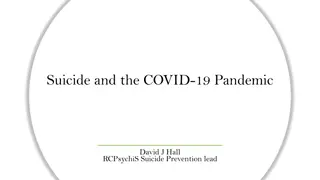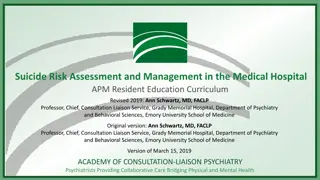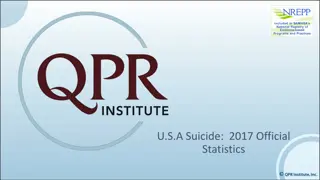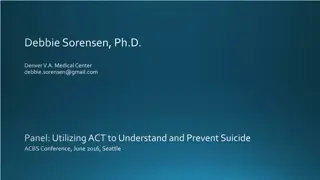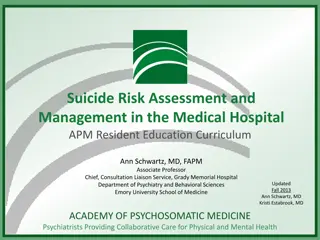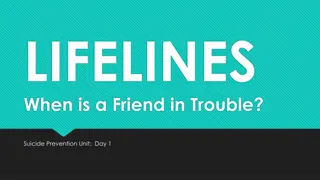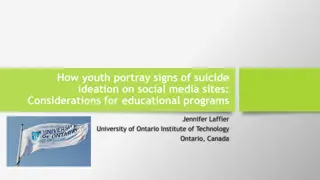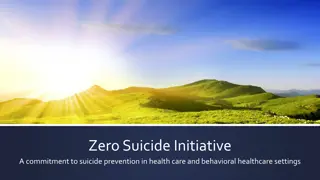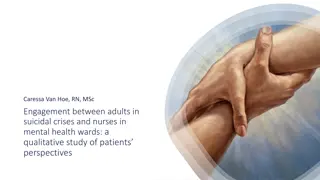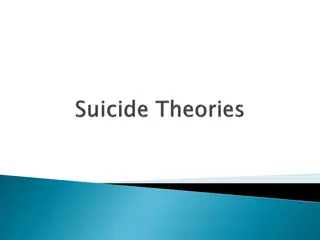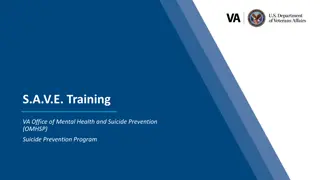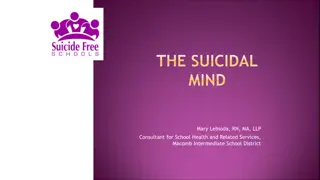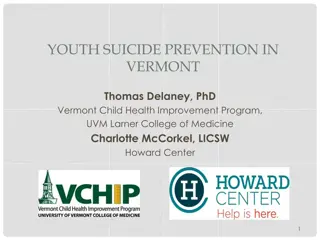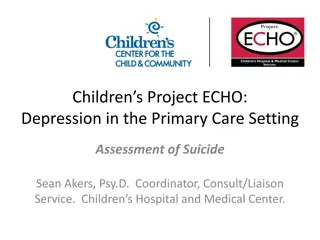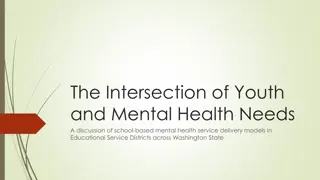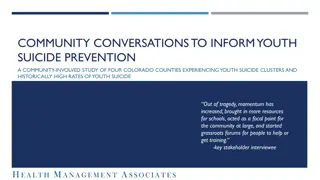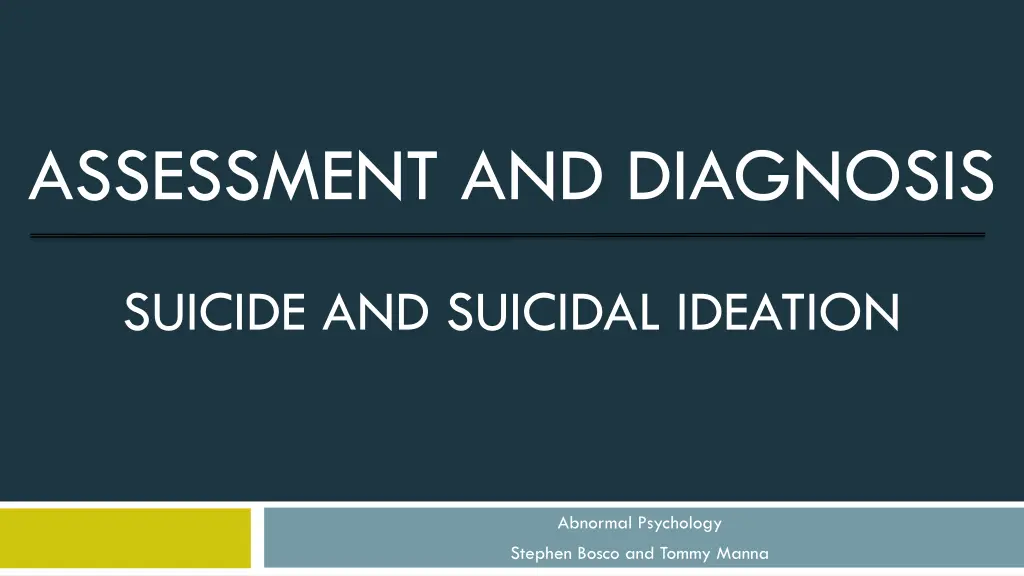
Understanding Suicide Risk Factors and Prevalence: A Comprehensive Overview
Explore the prevalence of suicide in the U.S., critical factors contributing to suicidal ideation, and the disproportionate impact on certain demographics. Learn about suicide risk factors such as mental health conditions, substance abuse, and historical influences, to better understand and address this critical issue.
Download Presentation

Please find below an Image/Link to download the presentation.
The content on the website is provided AS IS for your information and personal use only. It may not be sold, licensed, or shared on other websites without obtaining consent from the author. If you encounter any issues during the download, it is possible that the publisher has removed the file from their server.
You are allowed to download the files provided on this website for personal or commercial use, subject to the condition that they are used lawfully. All files are the property of their respective owners.
The content on the website is provided AS IS for your information and personal use only. It may not be sold, licensed, or shared on other websites without obtaining consent from the author.
E N D
Presentation Transcript
ASSESSMENT AND DIAGNOSIS SUICIDE AND SUICIDAL IDEATION Abnormal Psychology Stephen Bosco and Tommy Manna
PREVALENCE OF SUICIDE Suicide is the 10thleading cause of death in the US Each year 44,193 Americans die by suicide On average there are 121 deaths by suicide per day Firearms account for almost 50% of all suicides Men die by suicide 3.5x more often than women White males accounted for 7 of 10 suicides in 2015 Highest suicide rate is among adults between the ages of 45 and 64 Rates among adolescents and young adults (15 to 24 years) have been steadily increasing
PREVALENCE OF SUICIDE Tables In 2015, the highest U.S. suicide rate (15.1) was among Whites and the second highest rate (12.6) was among American Indians and Alaska Natives (Figure 5). Much lower and roughly similar rates were found among Hispanics (5.8), Asians and Pacific Islanders (6.4), and Blacks (5.6). Table retrieved from https://afsp.org/about-suicide/suicide-statistics/ From 1999 through 2014, the percent increase in the age-adjusted suicide rate was greater for females (45% increase) than males (16% increase), resulting in a narrowing of the gender gap in suicide rates (as measured by rate ratios). The ratio of male to female suicide rates was lower in 2014 (3.6) than in 1999 (4.5). Table retrieved from https://www.cdc.gov/nchs/products/databriefs/db241.htm
PREVALENCE OF SUICIDE - Tables Women are at a greater risk for suicidal ideation, attempts, and medically treated attempts than men. However, men die by suicide at a higher rate than women.
CRITICAL THINKING The rates of death by suicide and suicidal ideation disproportionately affect certain groups of people, my question to you is why? Take two minutes and write down potential reasons as to why certain groups of people have higher rates of suicide and suicidal ideation compared to others.
SUICIDE RISK FACTORS Health Factors Mental health conditions Substance abuse disorders Serious or chronic health condition and/or pain Environmental Factors Stressful life events Prolonged stress factors Access to lethal means Exposure to suicide Historical Factors Previous suicide attempts Family history
SUICIDE WARNING SIGNS TALK MOOD If a person talks about: being a burden, feeling trapped, having no reason to live, or killing themselves People who are considering suicide often display one or more of the following moods: Depression Loss of interest Rage Irritability Humiliation Anxiety BEHAVIOR Increase alcohol and drug usage Withdrawing from others Visiting or calling people to say goodbye Giving away prized possessions Aggression
SUICIDE TREATMENT Treatment for MDD Effectively assessing risk; combination of psychotherapy and medications Psychotherapies The most common types of psychotherapy for depression are cognitive behavior therapy (CBT), interpersonal therapy (IPT), behavioral activation (BH), and cognitive behavioral analysis system of psychotherapy (CBASP). Treatment for Bipolar Disorder Those with bipolar disorder are at greatest risk for suicide when they are in a depression or have a mixed mood state. Treatment for Substance and Drug Abuse Decrease consumption and increase social support
SUICIDE MYTHS MYTH: All suicidal people are depressed FACT: While depression is a contributory factor in most suicides, it need not be present for suicide to be attempted or completed MYTH: Most suicides happen suddenly without warning FACT: The majority of suicides have been preceded by warning signs, whether verbal or behavioral MYTH: People who talk about suicide are only trying to get attention. They won t really do it FACT: Those who are considering suicide give clues and warnings as a cry for help. In fact, most seek out someone to rescue them. Over 70% who do threaten to carry out a suicide either make an attempt or complete the act. MYTH: After a person has attempted suicide, it is unlikely he/she will try again. FACT: People who have attempted suicide are very likely to try again. 80% of the people who die from suicide have made at least one previous attempt.
THINK/PAIR/SHARE Take a minute and think about the previously mentioned myths regarding suicide and how they can stigmatize individuals who have attempted suicide or are thinking about committing suicide Turn to the person next to you and discuss what you thought about Then we will discuss this as a group
ASSESSMENT AND SUPERVISION ACTIVITY We are going to watch a clip from a TV show and while watching you are going to either assess the patient or the counselor. One group assessing the patient: You are the counselor assessing the suicidal risk and severity of the patient One group assessing the counselor: You are the supervisor assessing the counselor
THINK/PAIR/SHARE In your groups, Discuss what warning signs and risk factors you noticed in the patient Discuss the pros and cons about the counselor s assessment of suicidal risk Discuss the questions that you liked from the counselor and the questions you did not like. What questions do you wish the counselor asked? What would you have done if you were the counselor in this session?
ASSESSMENT OF THE PATIENT What did you hear or see from the patient that made you believe she may be suicidal or have suicidal intent? Direct Verbal Expression Reality: A direct statement of intention to commit suicide serves as one of the most useful single predictors. Take any such statement seriously. Feelings of hopelessness/Signs of Depression Reality: While depression is a contributory factor in most suicides, it need not be present for suicide to be attempted or completed Social Needs/Social Losses Reality: Most people who die by suicide have communicated some intent. Someone who talks about suicide gives the person they are speaking with an opportunity to intervene before suicidal behaviors occur.
ASSESSMENT OF THE COUNSELOR What did you hear or observe the counselor say or do that would be considered good practice or bad practice ? Reach out when additional help is needed Reality: All people who interact with suicidal adolescents can help them by way of emotional support and encouragement. Psychotherapeutic interventions also rely heavily on family, and friends providing a network of support. Telling someone to cheer up or Move on usually helps Reality: Trying to cheer someone up might make them feel even more misunderstood and ashamed of their thoughts and feelings. It s important to listen well and take them seriously. Express concern and care A sudden improvement in the mental state of an attempter following a suicidal crisis or depressive period signifies that the suicide risk is over Reality: The opposite may be true. In the three months following an attempt, a young person is at most risk of completing suicide. The apparent lifting of the problems could mean the person has made a firm decision to commit suicide and feels better because of this decision.
NATIONAL & LOCAL HELP IF YOU ARE FEELING SUICIDAL, THINKING ABOUT HURTING YOURSELF, OR ARE CONCERNED THAT SOMEONE YOU KNOW MAY BE IN DANGER OF HURTING HERSELF OR HIMSELF National Suicide Hotline: 1-800-273-8255 CWS @ Hunter College: 212-772-4931

